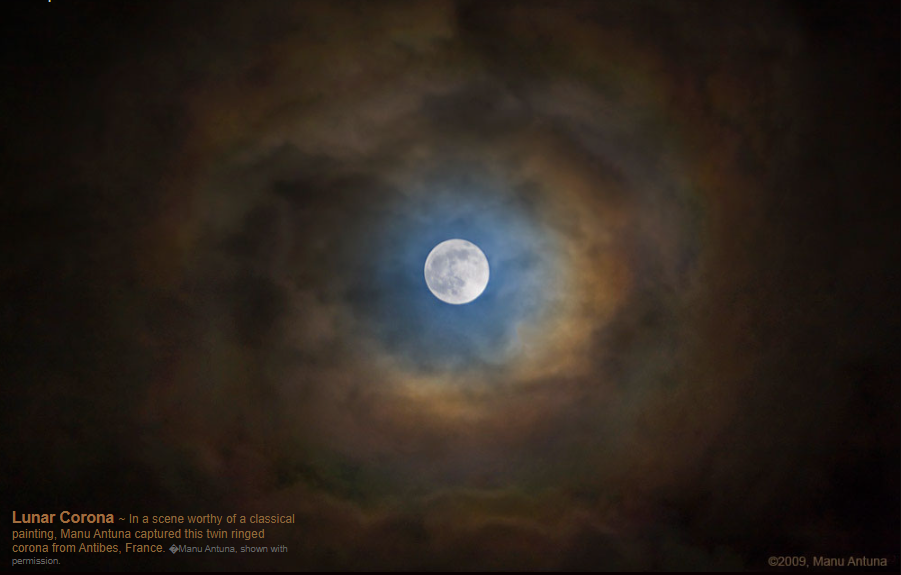Lunar Corona
Lunar Corona: A Celestial Phenomenon
Have you ever gazed up at the night sky and noticed a ring of light surrounding the Moon? This captivating sight is known as a Lunar Corona. Like a halo suspended in the heavens, the lunar corona is a fascinating atmospheric optics phenomenon that occurs when light interacts with tiny water droplets or ice crystals in the Earth's atmosphere. While the Moon itself does not emit light, it reflects sunlight, and this reflected light creates the ethereal spectacle of a lunar corona.
How Does a Lunar Corona Form?
To understand how a lunar corona forms, we need to delve into the science behind it. When light from the Sun or Moon encounters water droplets or ice crystals in the atmosphere, it undergoes a process called diffraction. Diffraction causes the light to bend and spread out, creating a circular pattern of colors around the source of light. This phenomenon is similar to what happens when light passes through a prism, resulting in a spectrum of colors.
The size of the water droplets or ice crystals plays a crucial role in the appearance of the lunar corona. Smaller particles produce a more defined corona with distinct rings, while larger particles can blur the edges and create a softer, diffused corona. The presence of these atmospheric particles also affects the size and intensity of the corona.
The Colors of a Lunar Corona
When observing a lunar corona, you may notice a range of colors within the rings of light. These colors result from the interference and diffraction of light waves as they interact with the water droplets or ice crystals. The specific colors observed can vary depending on factors such as the size and shape of the particles, as well as the angle at which they interact with the incoming light.
Typically, the innermost ring of a lunar corona appears bluish-white, followed by a series of alternating rings in colors such as pink, purple, and green. The outermost ring often appears reddish-orange. These colors add to the enchantment of the lunar corona and create a mesmerizing spectacle for skygazers.
Where and When Can You See a Lunar Corona?
Lunar coronas can be observed anywhere on Earth where the Moon is visible during nighttime or early morning hours. However, several conditions must align for a lunar corona to form. First and foremost, there must be a sufficient number of water droplets or ice crystals in the atmosphere. Additionally, the Moon must be relatively low on the horizon, allowing its light to pass through a greater portion of the atmosphere.
It is worth noting that lunar coronas are more commonly observed in regions with high humidity or during periods of fog or mist. These atmospheric conditions provide an abundance of water droplets or ice crystals for the light to interact with, increasing the likelihood of witnessing this celestial phenomenon.
Capturing the Beauty of a Lunar Corona
Photographing a lunar corona can be a rewarding endeavor for both amateur and professional photographers. To capture the intricate details of this atmospheric spectacle, it is recommended to use a telephoto lens and a tripod to ensure stability. Adjusting the exposure settings can also enhance the visibility of the corona's rings and colors.
When composing the shot, consider incorporating elements of the surrounding landscape to provide context and depth to the image. Whether it's a silhouette of trees or a distant cityscape, these additions can elevate the visual impact of the lunar corona photograph.
The Magic of Atmospheric Optics
Lunar coronas are just one example of the captivating phenomena that occur in our atmosphere. From rainbows and halos to sundogs and iridescence, atmospheric optics continually astound us with their beauty and complexity. These phenomena serve as a reminder of the intricate interplay between light and atmospheric particles, offering us a glimpse into the wonders of our natural world.
Next time you find yourself under a starry night sky, take a moment to appreciate the celestial marvels that surround us. Look up, and you may just witness the enchanting sight of a lunar corona, reminding us of the boundless wonders that await our exploration.

Lunar Corona ~ In a scene worthy of a classical painting, Manu Antuna captured this twin ringed corona from Antibes, France. �Manu Antuna, shown with permission
Note: this article has been automatically converted from the old site and may not appear as intended. You can find the original article here.
Reference Atmospheric Optics
If you use any of the definitions, information, or data presented on Atmospheric Optics, please copy the link or reference below to properly credit us as the reference source. Thank you!
-
<a href="https://atoptics.co.uk/blog/lunar-corona-4/">Lunar Corona</a>
-
"Lunar Corona". Atmospheric Optics. Accessed on November 26, 2024. https://atoptics.co.uk/blog/lunar-corona-4/.
-
"Lunar Corona". Atmospheric Optics, https://atoptics.co.uk/blog/lunar-corona-4/. Accessed 26 November, 2024
-
Lunar Corona. Atmospheric Optics. Retrieved from https://atoptics.co.uk/blog/lunar-corona-4/.